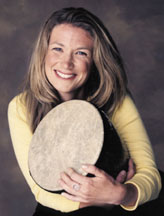| | Starting your own Drum Circle | |
Top Ten Tips for a Successful Drum Circle Event:
- Have participants remove their rings before playing hand drums. This protects their rings AND the drums.
- If you use chairs - make sure they don't have arm rests to best facilitate drumming.
- Identify "Welcomers" and "Greeters" who help people choose drums and get seated.
- Have Remo drums and percussion instruments beautifully displayed to allow people to discover the instrument that best fits their unique personality
- Be clear about the purpose and intention of the drum circle…what it is and what it isn't. Drum Circles are not a cure, but rather a tool that gets defined by the individual experience.

- Start with a strong beat that isn't too fast to follow. Often a low bass drum goes a long way to hold down the rhythm.
- Try having people add into a groove one at a time. The rhythm will naturally build and it allows people the opportunity to really listen to each other.
- Acknowledge the Ancestors and Cultures that have been practicing group drumming for centuries.
- End the circle with a "one-word symphony." Have each person stand up and say one word about their experience in the drum circle. Let the group find their own rhythm of speaking their word. Conclude with everyone standing.
- Ask them if they want to come back and do it again!
Top Ten Tips for Facilitating your own Drum Circle:
There are some great things you can do to prepare to facilitate a drum circle.
- Discover your own rhythm first. - From playing along with a recording to building up your confidence in expressing yourself musically, you can do a lot to demonstrate your love of music and inspire the circle. Don't be self-conscious and don't expect to "teach" anyone anything. Remember, its about helping people discover the rhythm that's already within them!
- Get the gear you need. - Outfit your group in good equipment. World percussion instruments by Remo are the perfect drum circle tools because they are light-weight, hold their pitch, and sound GREAT. It's important to have many different timbres:
- Bass (djembes, buffalo drums)
- Middle (bongos, smaller djembes)
- High (shakers)
- Nature sounds (thunder tube, and ocean drum)
- Invite people to bring their own drums and percussion, emphasizing what type of instruments you want there. Don't be afraid of found sounds or melodic pitched instruments like flutes or xylophones. Everything is really a percussion instrument.
- Create the space. - The drum circle actually begins long before anyone arrives. It is your job to set up the circle in your own personal way. Make it welcoming. Pay attention to your surroundings and make sure there's water available and ample space for a spontaneous dancer in the center. (To really encourage dancing - have a few shawls available!)
- Be prepared to stop the group. - In any new sport, we always learn how to stop before we go. If you were new at roller-blading, you would want to know how to stop before the harrowing task of skating down a mountain.
Using your voice to cue a stop over a group of drummers can be futile. Even the loudest, "1-2-3-4- STOP" can't be heard over a group of drummers. So, try cueing the group without using words. Your body becomes the conducting instrument. Experiment with this exercise.
***Stand in a quiet, comfortable posture. At the count of three, move quickly into a pose that demonstrates "stop." Come back to neutral and try it again, making each one bigger and clearer as your experiment and find your own personal way to signal a group to stop.
- Use dynamics. - In music, there is an ebb and flow of volume changes called "dynamics." By raising and lowering your hands, you can successfully cue the group to play louder or softer.
- Make people LAUGH! - Sometimes people are nervous about making music. They actually believed all those bad messages that, "they weren't musical," or that "they didn't have rhythm." To help people overcome these lies, find ways to help them laugh at themselves.
- Encourage "Heads-Up" drumming. - It's easy to get more into your own beat than noticing the group around you. Encourage people to steal rhythmic ideas from one-another, to learn from the exchange of rhythms within the circle. This creates more synchronicity and more connection.
- Try not leading at all. - A lot of time, there is no need for a facilitator. A group can often successfully jam together without a conductor. This is the ultimate. Don't try to do more than what the group needs you to do.
- Be yourself - Incorporate your unique gifts in the drum circle. From tap-dancing, playing a saxophone, singing, and dancing, bring all of your personality into your experience.
© Remo, Inc. All Rights Reserved.
Used by permission from HealthRHYTHMS, Remo, Inc.
| Christine Stevens is an international speaker, music therapist, and author. A modern-day troubadour, she introduces people all over the world to the power of musical expression. As......more |  |
|
|
Popular Related Articles/Areas
Popular & Related Products
Popular & Featured Events
Dimensions of Wellness
|
|